#lungfish fossil
Explore tagged Tumblr posts
Photo

Ceratodus Fossil Coprolites – Upper Triassic – Aust Cliff, Westbury Formation, UK – Authentic Specimen
Ceratodus Coprolite Fossils in Matrix – Upper Triassic – Aust Cliff, Westbury Formation, Penarth Group, Bristol, UK
This listing features a genuine fossil coprolite specimen, attributed to the prehistoric lungfish Ceratodus, embedded in original matrix from the famous fish, reptile, and coprolite bed at Aust Cliff, near Bristol. This site is part of the Westbury Formation, a classic Upper Triassic locality in the UK known for its rich vertebrate fossil content.
Scientific & Geological Details:
Location: Aust Cliff, Bristol, England, UK
Formation: Westbury Formation
Group: Penarth Group
Age: Upper Triassic (~205–210 million years ago)
Depositional Environment: Lagoonal to marginal marine with periodic anoxic conditions—ideal for preservation of vertebrate remains and trace fossils
Fossil Zone: Part of the Rhaetian Stage, marking the transition to the Jurassic
Notable Species: Ceratodus was a genus of lungfish, a group that still survives today in limited forms. These fish were adapted to low-oxygen waters and left behind spiral or pellet-like faecal fossils.
Morphological Features of the Coprolite:
Typically cylindrical or spiral in form
Surface texture may show subtle spiral markings (if not abraded)
Matrix may contain associated microvertebrate remains including fish scales or bone fragments
Represents trace fossil evidence (not the animal itself but its biological activity)
Specimen Information:
Discovery Date: 07 April 2025
Collected By: UKGE team members Alister and Alison
Preparation: Expertly cleaned and stabilised by Alison
Scale Reference: Shown alongside a 1cm cube for exact sizing – see photographs for dimensions and angles
What You See Is What You Get: The photos show the exact item you will receive
Authenticity: Supplied with a Certificate of Authenticity. All our fossils are 100% genuine and responsibly sourced.
Educational and Collectible Value:
This coprolite offers a fascinating window into ancient biological processes and Triassic ecosystems. It's a perfect specimen for collectors, educators, students, and anyone interested in paleobiology or the evolution of vertebrate life. Trace fossils like this are invaluable for reconstructing diet and environmental conditions of ancient species.
#fossil coprolite#Ceratodus coprolite#Upper Triassic fossil#Aust Cliff fossil#Westbury Formation#Penarth Group#fish coprolite#lungfish fossil#ancient fish droppings#genuine fossil#prehistoric fish#UK fossil bed#coprolite specimen#fossilised faeces#vertebrate trace fossil
0 notes
Text

A Cretaceous lungfish tooth plate of a Neoceratodus africanus or Ceratodus sp. from the Elrhaz Formation in Gadoufaoua, Niger. These giant Mesozoic lungfish would have been prey for genera like Suchomimus tenerensis and Sarcosuchus imperator.
#fish#lungfish#dipnoi#fossils#paleontology#palaeontology#paleo#palaeo#neoceratodus#ceratodus#ceratodontidae#neoceratodontidae#cretaceous#mesozoic#prehistoric#science#paleoblr#ネオケラトドゥス#ケラトドゥス#ネオセラトーダス#セラトーダス#ハイギョ#化石#古生物学#ケラトドゥス科
134 notes
·
View notes
Text
Fish of the Day
Happy Thursday, everyone! Today's fish of the day is the Australian lungfish!

The Australian lungfish, or barramunda, known by scientific name Neoceratodus forsteri is one of the 6 surviving lungfishes of the modern world. The other 5 lungfishes are scattered to other sections of the world, one in South America, and the other 4 all living in Africa. As the name implies, this lungfish is endemic to Australia living in South Eastern Queensland, or for those who don't know the general areas of Australia, the upper right corner of the country. Living exclusively in slow moving streams, still waters, and various waterside banks living entirely in freshwater systems. This fish is primarily nocturnal, and almost entirely carnivorous. Its diet consists of: frogs, larvae, bugs, plant material, earthworms, fishes, small invertebrates, and anything else it can catch. They are primarily bottom dwellers, and prey is caught directly in the mouth and then crushed multiple times, being positioned correctly by a bone called a hydroid apparatus. Australian lungfish have the most primitive of surviving lungfish feeding behaviors.

Australian lungfish are best known for their ability to survive dry seasons. However, unlike African lungfish, which can survive fully in droughts by submerging themselves into This is done by submerging the body in the mud, and rising to the surface to swallow oxygen into a single dorsal lung. This lung is only supplementary, and the fish prefer to breathe through their 5 gills. Of the six lungfish, the Australian lungfish is the only one to not have two lungs, but rather a fold down the center of the single lung acting as a wall, which blood capillaries run through, allowing gas exchange. Unlike it's African counterparts, the Australian lungfish can not survive total water depletion, (other lungfish survive this by creating a layer of mucus around itself and living there for several years until water returns). Australian lungfish can survive several days out of the water, but can not do so unless it is in a moist environment, usually mud.

Fossil records of lungfish tell us that some of their first fossils can be found from 410 Million years ago, being the closest living relative to the tetrapod. The last shared ancestor between the lungfish and tetrapod was 420 Million year ago. Originally, these animals started as marine creatures, but sometime in the carboniferous the species became freshwater exclusive, around the same time that the last common ancestor to all remaining lungfish lived. Australian lungfish in particular appear to have split off about 380 million years ago, and have remained virtually unchanged from their ancestors for over 100 million years, giving them the title of living fossils!

Not only have they remained incredibly similar over the years, they have a long lifespan for individuals as well. A captive Australian lungfish named granddad was shown to live to 108 years (+- 6), with the expected lifespan of wild lungfish surviving at least 20-25 years after they reach sexual maturity. In Australian lungfish, similar to other lungfish species in the world, sexual maturity is reached in males after 17 years, and 22 years in females. Australian lungfish have elaborate courting rituals consisting of three distinct phases. The first phase is searching, where the lungfish will breathe loudly, making mating calls with its single lung. The second is called "follow the leader" where males will attempt to entice a female by nudging and rubbing snouts with her, often at the same time as competitors. The last stage is where two lungfish will descend to lay and fertilize eggs, females producing 2 eggs per spawning season. After breeding, the eggs are left to sink in the vegetation, as Australian lungfish do not nest or care for their young. This is unlike all other lungfish species.

Have a wonderful Thursday, everyone!
#fish#fish of the day#fishblr#freshwater fish#freshwater#australian lungfish#Barramunda#queensland lungfish#lungfish#australia#living fossils
128 notes
·
View notes
Text
Official nature post

Living Fossils - Creatures that remain seemingly unchanged by time. Here's the Coelacanth, the Sturgeon, the Gar, the Horseshoe Crab and the Nautilus! (Gouache on 50x40cm canvas, SOLD)
12K notes
·
View notes
Text
I recently found out a show I liked is 10 years old now so to not be the oldest thing on this blog I'm talking coelacanths for Wet Beast Wednesday. Coelacanths are rare fish famed for being living fossils. While that term is highly misleading, it is true that coelacanths are among the only remaining lobe-fined fish and were thought to have gone extinct millions of years ago before being rediscovered in modern times.
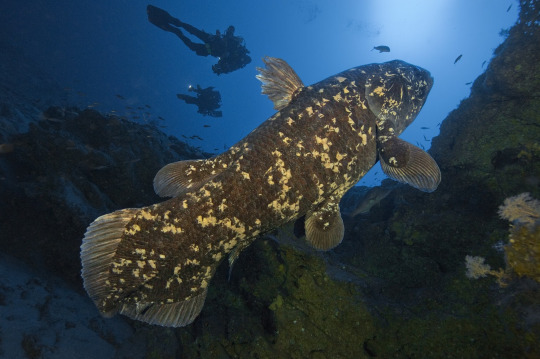
(image id: a wild coelacanth. It is a large, mostly grey fish with splotches of yellowish scales. Its fins are attached to fleshy lobes. It is seen from the side, facing the top right corner of the picture)
Coelacanth fossils had been known since the 1800s and they were believed to have gone extinct in the late Cretaceous period. That was until December 1938, when a museum curator named Marjorie Courtenay-Latimer was informed of an unusual specimen that had been pulled in by local fishermen. After being unable to identify the fish, she contacted a friend, ichthyologist J. L. B. Smith, who told her to preserve the specimen until he could examine it. Upon examining it early next year, he realized it was indeed a coelacanth, confirming that they had survived, undetected, for 66 million years. Note that fishermen living in coelacanth territory were already aware of the fish before they were formally described by science. Coelacanths are among the most famous examples of a lazarus taxon. This term, in the context of ecology and conservation, means a species or population that is believed to have gone extinct but is later discovered to still be alive. While coelacanths are among the oldest living lazarus taxa, they aren't the oldest. They are beaten out by a genus of fly (100 million years old) and a type of mollusk (over 300 million years old).

(image: a coelacanth fossil. It is a dark brown imprint of a coelacanth on white rock. Its skeleton is visible in the imprint)
Coelacanths are one of only two surviving groups of lobe-finned fish along with the lungfishes. Lobe-finned fish are bony fish notable for their fins being attached to muscular lobes. By contrast, ray-finned fish (AKA pretty much every fish you've ever heard of that isn't a shark) have their fins attached directly to the body. That may not sound like a big difference, but it actually is. The lobes of lobe-finned fish eventually evolved into the first vertebrate limbs. That makes lobe-finned fish the ancestors of all reptiles, amphibians, and mammals, including you. In fact, you are more closely related to a coelacanth than a coelacanth is to a tuna. Coelacanths were thought to be the closest living link to tetrapods, but genetic testing has shown that lungfish are actually closer to the ancestor of tetrapods.
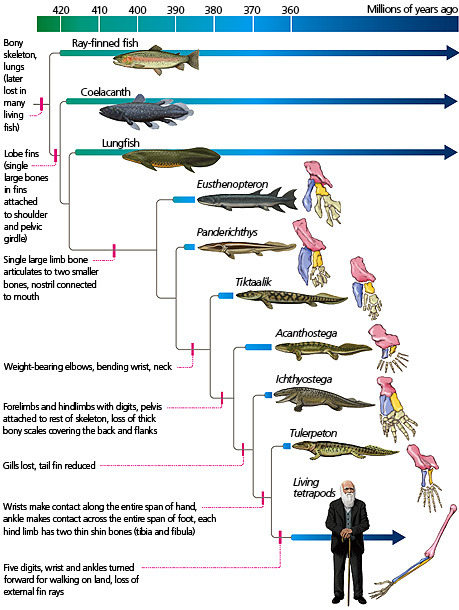
(image id: a scientific diagram depicting the taxonomic relationships of early lobe-finned fish showing their evolution to proto-tetrapods like Tiktaalik and Ichthyostega, to true tetrapods. Source)
There are two known living coelacanth species: the west Indian ocean coelacanth (Latimeria chalumnae) and the Indonesian coelacanth (L. menadoensis). Both are very large fish, capable of exceeding 2 m (6.6 ft) in length and 90 kg (200 lbs). Their wikipedia page describes them as "plump", which seems a little judgmental to me. Their tails are unique, consisting of two lobes above and below the end of the tail, which has its own fin. Their scales are very hard and thick, acting like armor. The mouth is small, but a hinge in its skull, not found in any other animal, allows the mouth to open extremely wide for its size. In addition, they lack a maxilla (upper jawbone), instead using specialized tissue in its place. They lack backbones, instead having an oil-filled notochord that serve the same function. The presence of a notochord is the key characteristic of being a chordate, but most vertebrates only have one in embryo, after which it is replaced by a backbone. Instead of a swim bladder, coelacanths have a vestigial lung filled with fatty tissue that serves the same purpose. In addition to the lung, another fatty organ also helps control buoyancy. The fatty organ is large enough that it forced the kidneys to move backwards and fuse into one organ. Coelacanths have tiny brains. Only about 15% of the skull cavity is filled by the brain, the rest is filled with fat.
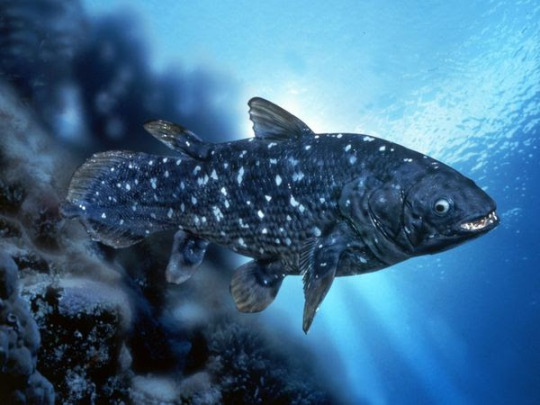
(image id: a coalacanth. It is similar to the one on the above image, but this one is blue in color and the head is seen more clearly, showing an open mouth and large eye)
One of the reasons it took so long for coelacanths to be rediscovered is their habitat. They prefer to live in deeper waters in the twilight zone, between 150 and 250 meters deep. They are also nocturnal and spend the day either in underwater caves or swimming down into deeper water. They typically stay in deeper water or caves during the day as colder water keeps their metabolism low and conserves energy. While they do not appear to be social animals, coelacanths are tolerant of each other's presence and the caves they stay in may be packed to the brim during the day. Coelacanths are all about conserving energy even when looking for food. They are drift feeders, moving slowly with the currents and eating whatever they come across. Their diet primarily consists of fish and squid. Not much is known about how they catch their prey, but they are capable of rapid bursts of speed that may be used to catch prey and is definitely used to escape predators. They are believed to be capable of electroreception, which is likely used to locate prey and avoid obstacles. Coelacanths swim differently than other fish. They use their lobe fins like limbs to stabilize their movements as they drift. This means that while coelacanths are slow, they are very maneuverable. Some have even been seen swimming upside-down or with their heads pointed down.
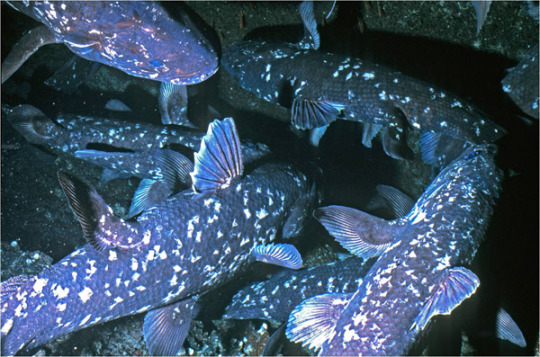
(image: an underwater cave wilt multiple coelacanths residing in it. 5 are clearly visible, with the fins of others showing from offscreen)
Coelacanths are a vary race example of bony fish that give live birth. They are ovoviviparous, meaning the egg is retained and hatches inside the mother. Gestation can take between 2 and 5 years (estimates differ) and multiple offspring are born at a time. It is possible that females may only mate with a single male at a time, though this is not confirmed. Coelacanths can live over 100 years and do not reach full maturity until age 55. This very slow reproduction and maturation rate likely contributes to the rarity of the fish.
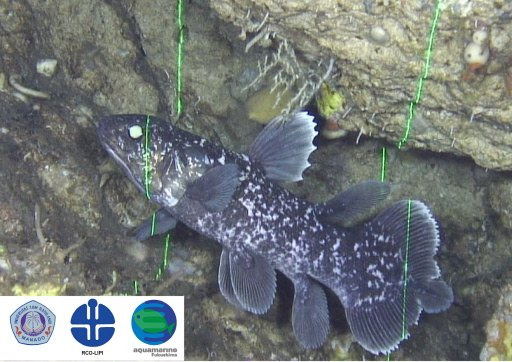
(image: a juvenile coelacanth. Its body shape is the same as those of adults, but with proportionately larger fins. There are green laser beams shining on it. These are used by submersibles to calculate the size of animals and objects)
Coelacanths are often described as living fossils. This term refers to species that are still similar to their ancient ancestors. The term is losing favor amongst biologists due to how misleading it can be. The term os often understood to mean that modern species are exactly the same as ancient ones. This is not the case. Living coelacanth are now known to be different than those who existed during the Cretaceous, let alone the older fossil species. Living fossils often live in very stable environments that result in low selective pressure, but they are still evolving, just slower.
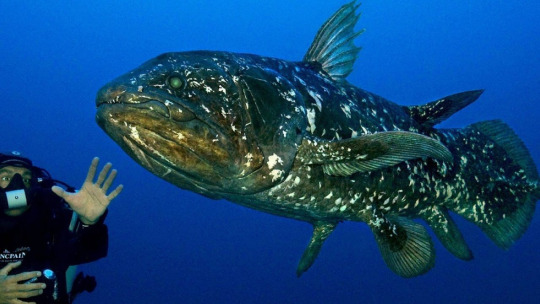
(image: a coelacanth swimming next to a SCUBA diver)
Because of the rarity of coelacanths, it's hard to figure out what conservation needs they have. The IUCN currently classifies the west Indian ocean coelacanth as critically endangered (with an estimated population of less than 500) and the Indonesian coelacanth as vulnerable. Their main threat is bycatch, when they are caught in nets intended for other species. They aren't fished commercially as their meat is very unappetizing, but getting caught in nets is still very dangerous and their slow reproduction and maturation means that it is long and difficult to replace population losses. There is an international organization, the Coelacanth Conservation Council, dedicated to coelacanth conservation and preservation.
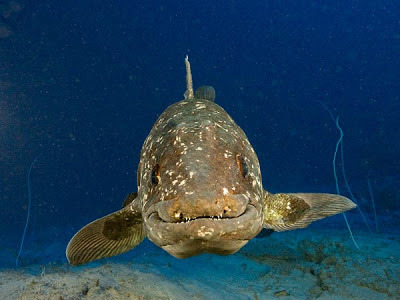
(image: a coelacanth facing the camera. The shape of its mouth makes it look as though it is smiling)
#wet beast wednesday#coelacanth#marine biology#biology#zoology#ecology#animal facts#fish#fishblr#old man fish#lobe-finned fish#sarcopterygii
1K notes
·
View notes
Text

Expedition Pilgrims
Sha Wujing (435cm): His outfit is mostly inspired by Mongolian clothes since he's found in the Gobi desert stretch of the journey. His bangles are made of fossil bone, and he can use the waist cloth as a headwrap during adverse weather. His markings are inspired by African Lungfish and Mudfish fins, as they are species that exist somewhere between water and dry air. The beasts on his knees are an extension of him, and he can see and speak through them as needed. His beard and long hair can have Ghibli physics depending on his mood and emotions. Zhu Wuneng (~300cm): Inspired by Northern Tibetan clothes, as that's the region the group recruits him. Traditional clothes tend to have way more accessories and golden details so I had to simplify a bit. His features are a mix of wild boars and Indonesian babirusa, with the iconic bristles on his head. I leaned on ceremonial Tibetan swords and necklace beads for the decorations on his rake. His vest can be closed, he just prefers not to most of the time. Sun Wukong (125cm): I've already commented on his design over here, but I'll elaborate that the yellow shirt is the one he gained from Tripitaka soon after he was released, while the pants and red half-robe were the garments he was given by Guan Yin. The hoops on his feet and purple beads were reacquired back in Huaguoshan when he first fled the pilgrimage, heading to his family instead of Ao Guang's palace. (A-ma and Jinju gave them to him so he'll always have something to home to remember them by, as well as where he first started, as the beads were gained during his lessons with Subodhi.) Tripitaka (163cm): This is but one of his many outfits since travel can be rough on clothes, and even more so when you get kidnapped by demons and thrown off your horse all the time. He wears the usual orange monk robes, with some kind of travel clothes over them. He gains some fur boots from Boquin for cold weather but usually prefers sandals most of the time. He seldom uses the cassock and crown he received from Guan Yin, save for when he pays respects to temples and holy sites, but the staff is a constant companion. Ao Lie (167cm, 130cm at the shoulder as horse): Being effectively in exile until the journey is complete, he wears less fancy clothes than he usually would as a prince, but his status still shows. I tried to balance more casual hanfu of the era with some armor parts, like the waist guard and armored boots. He was given the skill to shapeshift into a horse by Guan Yin when she commanded him to wait for the chosen pilgrim monk, so he can shift at will, but preferably when the tack has been taken off. Speaking of, tack is lost and replaced multiple times during the journey, so I didn't depict any specific one.
my Expedition AU designs and heights for the five lads, ive spent so much time on this its not even funny lololol but hey it's done!! i'm free!!
#journey to the west#jttw#xiyouji#jttw au#jttw fanart#expedition to the west au#Sun clan au#bell dragon art#sun wukong#monkey king#sha wujing#zhu bajie#tang sanzang#tang xuanzang#tripitaka#bai longma#ao lie
1K notes
·
View notes
Text
Round 2 - Chordata - Actinistia


(Sources - 1, 2)
The Sarcopterygians (“Lobe-finned Fishes”), are the last of the three groups of “fish”, and are so named for the prominent muscular limb buds (lobes) within their fins. Of the Sarcopterygians living today, they are represented by the coelacanths, lungfish, and tetrapods (including humans), who all diverged in the Silurian. These next fish are closer related to us than they are to Actinopterygiians.
The class Actinistia, the “Coelacanths”, are an ancient group of fish that have been around since the Devonian but today are only represented by two remaining species: The West Indian Ocean Coelacanth (Latimeria chalumnae) and the Indonesian Coelacanth (Latimeria menadoensis).
Coelacanths can live as deep as 700 m (2,300 ft) below the sea, but are more commonly found at depths of 90 to 200 m (300 to 660 ft). They have sensitive eyes which include a tapetum lucidum and many rods which help them see better in dark water, as they are most active at night. They are opportunistic hunters, feeding on cuttlefish, squid, snipe eels, small sharks, and other fish found around their deep reef and volcanic slope habitats. Their abundance of fins allow for high maneuverability, and coelacanths can orient their body in almost any direction in the water. They have been seen doing headstands as well as swimming belly up. They are able to slow their metabolisms at will, sinking into less-inhabited depths and going into a hibernation mode to conserve energy.
Coelacanths are ovoviviparous, with the female retaining the fertilized eggs within her body while the embryos develop over a gestation period of five years. The female will give live birth to around 5-26 young. Young coelacanths resemble the adult, but carry an external yolk sac below their pelvic fins, and have larger eyes relative to body size. Individual coelacanths may live as long as 80 to 100 years.
Coelacanths get their name from Coelacanthus, a genus of Permian coelacanths and the first coelacanths to be described. Over 100 fossil species are known, and all of them were believed to have gone extinct in the Cretaceous. On December 23, 1938, the first Latimeria specimen was discovered among the catch of a South African fisherman, making coelacanths a “lazarus taxon.” While previously considered a “living fossil”, coelacanth body shapes were much more diverse in the Early Triassic, and Latimeria is not known from fossils, showing that it had to have gone through some changes to adapt to the modern day.

Propaganda under the cut:
Since there are only two living species in this class and both are threatened, this is the most endangered class of animals in the world.
Coelacanths get along with other coelacanths, though they recoil from physical touch. Scientists think that they recognize each other via electric communication.
Mawsonia was one of the largest known coelacanths, with one specimen estimated at over 5 m (16 ft) long. It lived from the Late Jurassic to Mid-Cretaceous.
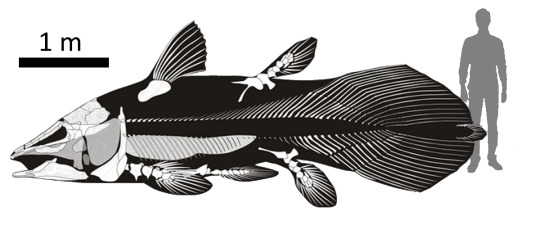
(source)
90 notes
·
View notes
Text
I cannot express how much I LOVE this
video from: California Academy of Sciences
#im crying i want to hold her in my arms so bad#adorable animals#fish#always a paleontology adventure#lungfish#living fossils
39K notes
·
View notes
Text
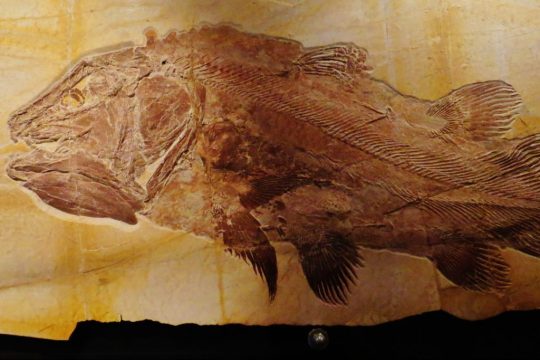
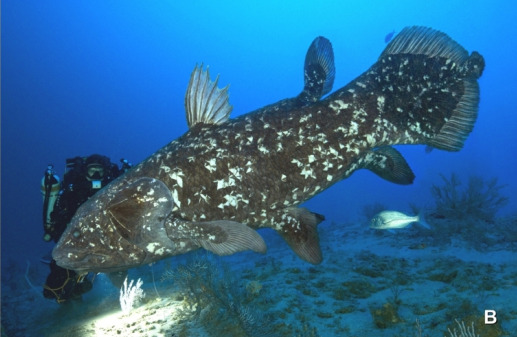
Happy Fossil Friday!
Who: Coelacanthiformes
What: Coelacanths! Large lobe-finned fish from the Class Actinistia, a close relative of the lungfish.
When (group): Devonian - Present (thought to have gone extinct during the End-Cretaceous extinction event, but members of the group were "rediscovered" in 1938)
Where: (Living representatives) along the east African coast and the Comoros Archipelago in the Indian Ocean.
(Fossil representatives) England, Czech Republic, France, Germany, India, Switzerland, Brazil, Democratic Republic of the Congo, China, Uruguay, USA, and more.
Fun Fact!: There are two living speices (that we know of) of Coelacanth: Latimeria chalumnae & Latimeria menadoensis
Here is a link to an article for the story of how this "living-fossil" was rediscovered by the scientific community and the museum curator who's quick thinking and determination helped bring this animal back into the spotlight.
Why are they cool?: Instead of the bony vertebral column shared by other vertebrates the coelacanth retains the ancestral fluid filled notochord which is less rigid than vertebrae, but offers more flexibility.
Image Credits: (Left) Coelacantheformes Fossil From the Natural History Museum of Bamberg & (Right) Laurent Ballesta - Gombessa Expéditions
160 notes
·
View notes
Text
Fossil Friday: Lisowicia bojani
I am still geeking out over how far this animal made it during March Madness. Lisowicia bojani lived in Poland during the Late Triassic Period about 210-205 Ma. It was discovered in 2006 by Polish paleontologists Jerzy Dzik, Tomasz Sulej and Grzegorz Niedźwiedzki, who initially thought it was a sauropodomorph. I mean, can you blame them? This thing is HUGE. it wasn't officially named until 2019 though.
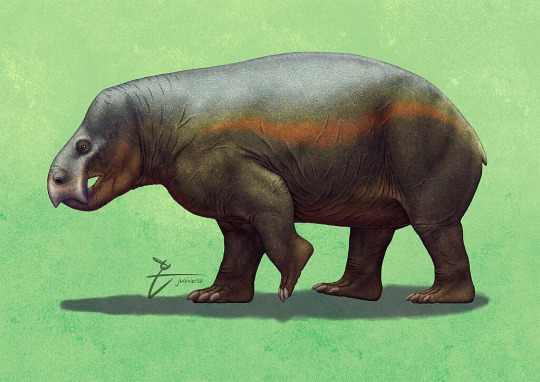
It was found in the Lipie Śląskie clay pit which consists mostly of green mudstones. It's home would have been wet and swampy, akin to the modern day Everglades with large meandering rivers, oxbow lakes and surrounded by abundant vegetation, mostly conifers, ferns, and cycads.
It lived alongside animals such as the archosaurs Smok (who was probably the apex predator),

a silesaurid, a small theropod dinosaur, pterosaurs, a small crocodylomorph, a sphenodont, primitive amphibians, lungfish, coelacanths, hybodontid sharks and a smaller synapsid called Hallautherium.
it belongs in the phylum Chordata (vertebrates) in the clade Amniota in the smaller Synapsida clade (animals with one pair of temporal fenestrae in their skull), continuing into the even smaller Therapsida clade (mammals and their closest relatives).

Within Therapsida, they belong to the suborder anomodontia in the clade dicynodontia.
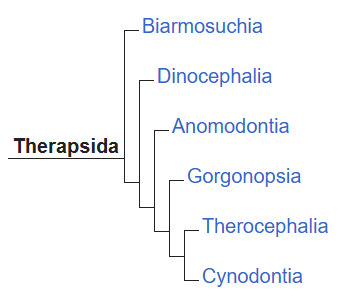

Dicynodonts are a group of tusked, beaked herbivorous synapsids that ranged from the mid-Permian to the Late Triassic. Lisowicia was the largest of this highly successful group.

It had very large temporal fenestrae which allowed for large jaw muscles to attach at the back of the skull. It was a stocky animal like its closest relatives. It was completely toothless and lacked the tusks of other dicynodonts
It's cervical vertebrae have hollows excavated along the lateral sides but lack pleurocoels so their function is currently unknown.
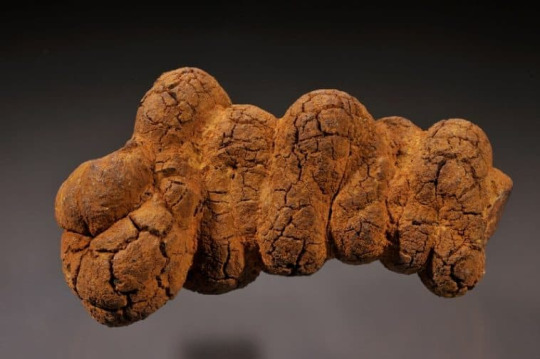
Coprolites attributed to Lisowicia have been found in abundant accumulations that have been interpreted as a sort of communal bathroom. It seems these animals could have been litter box trained! Within these coprolites have been found evidence of soft vegetation and conifers and occasionally woody material.

The bones of Lisowicia lack clear lines of arrested growth (LAGs) which might suggest that they grew very rapidly without interruptions until they reached adult size. LAGs may have either been absent or erased due to extensive remodeling of bone into adulthood which is similar to mammals and some dinosaurs. This would support permanently rapid growth.
Hope you enjoyed this week's lessons and I hope you tune in Monday to learn about another popular metal. Fossilize you later!
#paleontology#fossils#fun facts#science education#science#science side of tumblr#synapsid#dicynodont#march madness
17 notes
·
View notes
Photo

RARE Fossil Ceratodus Coprolite with Reptile Bones Westbury Formation Triassic Aust Cliff Bristol UK Authentic
This listing features a rare and highly sought-after fossil coprolite (fossil poo) attributed to the prehistoric lungfish genus Ceratodus, preserved within a fossil-rich block containing reptile bone fragments. The specimen was discovered by our expert team (Alister & Alison) on 07 April 2025 at the renowned Aust Cliff, Bristol, from the Westbury Formation, Penarth Group, dating to the Upper Triassic period (~208 million years ago).
The Westbury Formation at Aust Cliff is internationally famous for its fish, reptile and coprolite bed, a layer of sediment rich in vertebrate remains deposited in a lagoonal to marginal marine environment during the final stages of the Triassic. This locality marks the transition between the Triassic and Jurassic periods and has yielded numerous important fossils.
About Ceratodus & This Coprolite:
Genus: Ceratodus (prehistoric lungfish)
Fossil Type: Coprolite with visible inclusions of bone and possible scale fragments
Morphology: Elongated cylindrical coprolite with surface impressions, fine preservation of inclusions
Preservation: The coprolite is mineralised, likely composed of calcium phosphate, showing embedded reptilian bone debris, which may have been ingested
Reptile Bone Inclusions:
Small fossil bone fragments embedded within or alongside the coprolite
May originate from small reptiles or amphibians inhabiting the same depositional environment
Geological & Scientific Details:
Species Attribution: Ceratodus sp. (coprolite producer)
Geological Formation: Westbury Formation
Group: Penarth Group
Depositional Environment: Marginal marine to lagoonal (low oxygen, promoting fossil preservation)
Geological Age: Upper Triassic (Rhaetian Stage)
Biozone: Rhaetian Vertebrate Bed (informal, Aust Cliff local faunal assemblage)
Location: Aust Cliff, Bristol, United Kingdom
This fossil not only showcases a fascinating example of prehistoric digestive processes but also preserves part of the food web from the Triassic ecosystem. Specimens with multiple fossil elements from this famous bed are rarely available.
The photo shows the actual specimen you will receive. Scale cube = 1cm. For full sizing, please see the image.
All of our Fossils are 100% Genuine Specimens & come with a Certificate of Authenticity.
Carefully selected, professionally cleaned and prepped by Alison, this is an exceptional collector's item from a site of international palaeontological significance.
#Ceratodus coprolite#fossil fish poo#reptile bone fossil#Aust Cliff fossil#Westbury Formation#Penarth Group#Upper Triassic fossils#coprolite with bone fragments#UK vertebrate fossil#fish coprolite#fossil faeces#Triassic coprolite#Ceratodus tooth#lungfish coprolite#ancient reptile bone#fossil bone block#Bristol fossil site
0 notes
Text
Lungfish have inhabited Earth for so long, and gone through such weird evolution, it's not surprising these ancient creatures have collected a lot of viral and other DNA over the millennia... heck, over the ages!
The longest genome of all the animals on Earth belongs not to a giant, or a cognitively advanced critter, but a writhing, water-dwelling creature seemingly frozen in time, right at the cusp of evolving into a beast that can live on land. These are the lungfish, a class of freshwater vertebrates whose peculiar characteristics are reflected in a colossal genetic code. Able to breathe both air and water, with limb-like fins, and a well-developed skeletal architecture, these strange ancient creatures are thought to is thought to share a common ancestor with all four-limbed vertebrates known as tetrapods.
Continue Reading.
302 notes
·
View notes
Text

A Triassic lungfish tooth plate, likely an Arganodus atlantis or Ceratodus arganensis from the Argana Group in the Argana Basin of Morocco. Arganodus has sometimes been synonomized with the genus Asiatoceratodus. This specimen comes from a very old French collection from the 1960s and unfortunately lacks detailed locale information.
#fish#lungfish#dipnoi#fossils#paleontology#palaeontology#paleo#palaeo#arganodus#ceratodus#asiatoceratodus#arganodontidae#ceratodontidae#asiatoceratodontidae#triassic#mesozoic#prehistoric#science#paleoblr#アルガノドゥス#ケラトドゥス#アジアトケラトドゥス#ハイギョ#アルガノドゥス科#ケラトドゥス科#アジアトケラトドゥス科#化石#古生物学
132 notes
·
View notes
Text
Fish of the Day
Today's fish of the day is the longnose gar!

The longnose gar, known well within North America by anglers, and for their distinctive snout. Scientific name Lepisosteus osseus, meaning bony or armor-scaled bony fish. Gars, as a particularly old species are often referred to as living fossils, in that many of them are exactly the same as the fossils of them we have been finding from millions of years earlier, and the longnose gars are no different. Gars first start appearing within the fossil record around 240 million years ago, and are the only remaining decedents of the Ginglymodi clade, a particularly successful fish group in the Mesozoic era. The reason for their low amount if speciation is because gars are the slowest rate of molecular evolution among jawed vertebrates.

These gar fossils can be found worldwide, but the longnose gar can first be found in the fossil records around 1.8 million years ago, fossils found in Cuba, Kansas, Central America, and area in-between. In the modern day the longnose gar lives along mainly the Mississippi River and the Eastern United States freshwater rivers, although they can handle relatively high salinity, giving them the ability to live in estuaries that other gars can not. In these environments they spend their times living in the shadow of vegetation, usually near fallen trees that they can hide within, or near rocky outcroppings that they can camouflage near, or sea grasses.

Referred to as a primitive fish sometimes, this is because their lack of change over the years. The longnose gar in particular is known for having their intestines in a shape referred to as a spiral valve. A spiral valve is a section of lower intestine that is shaped in a stack of potato chips on top of one another, with a spiral going between them, similar to the look of fish gills when opened, found only within animals that are particularly old and living fossils (sharks, sturgeons, lungfish, paddlefish, and gars). Shaped this way for excess absorption. other than this they also have some old trait such as the bony scaling referred to as ganoid scales, which can also be found in some variation on sturgeon.
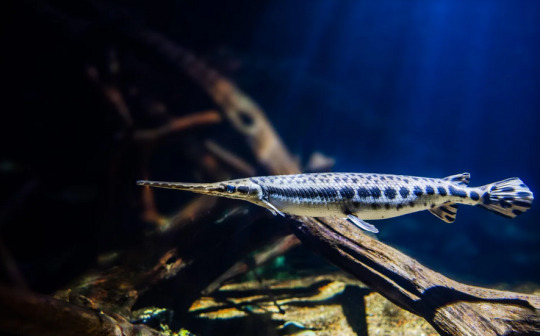
Their diet consists of mainly insects and crustaceans, and occasionally small gamefish that they can catch, although this is a rare occasion and mostly made up of fry. Other than humans, they not predated upon, and are apex predators in their environments. Their lifehistory is rather long compared to the fish they live around, but shorter than most gar, living 15-20 years, although in captivity there have been longnose gars that live as long as 40 years. These animals spawn in the summertime from April-July, having as many as 30,000 eggs at a time which are spawned in areas of smooth stones, where the eggs will stick. These animals usually reach sexual maturity around 6 years but some males will reach maturity at 2 years of age. Once they reach their full size they can get as long as 4-5 feet and can weigh more than 50 pounds.

Have a wonderful day!
#fish#fish of the day#fishblr#fishposting#aquatic biology#marine biology#freshwater#freshwater fish#animal facts#animal#animals#fishes#informative#education#aquatic#aquatic life#nature#river#ocean#longnose gar#gar#garfish\#Lepisosteus osseus
47 notes
·
View notes
Text
Mod 2 General Topics
Types of Fins
Fins are thin, broad folds of integument internally supported by fin rays, they aid in locomotion in various ways depending on the type of fins.
There are 2 kinds of adult fish fins: unpaired median and paired lateral.
Unpaired median fins include 1-2 dorsal fins along the mid-dorsal line, a ventral anal fin behind the anus/cloaca and a caudal fin around the tip of the tail.
Paired lateral fins include pectoral fins anteriorly and pelvic fins posteriorly. Pelvic fins are called thoracic when located below the pectoral fins and abdominal when located just above the anus. Absent in some.
Under unpaired fins there are many types of caudal fins. Caudal fins are well developed in most fish because of its important contribution to forward propulsion during swimming. The 3 main types are: diphycercal, heterocercal, and homocercal.
Diphycercal Fins:
The most primitive, not exhibited by many living fish.
Vertebral column extends straight back to the tip of the tail, dividing the fin symmetrically and equally into the dorsal and ventral lobes.
Occurs in cyclostomes, primitive sharks, and lungfish.
Presence of diphycercal tail in developed fish is due to secondary modifications.
Heterocercal Fins:
Intermediate type.
The caudal fin is strongly asymmetrical.
Vertebral column bends upwards and reaches up to the tip of the more prominent dorsal lobe.
Characteristic in bottom feeders with a ventral mouth, the stroked of the large dorsal lobe directs the fish downwards.
Occurs in modern sharks.
The opposite, a large ventral lobe, is found in flying fish to propel them upwards. This type of fin is called hypocercal.
Homocercal Fins:
The most advanced type and the most common.
Characteristic of most higher bony fishes.
Externally symmetrical but internally asymmetrical.
The original dorsal lobe or epichordal is suppressed, the original ventral love is developed into a single or 2 symmetrical lobes.
Characteristic of fishes with a terminal mouth, its strokes force the fish straight forward.
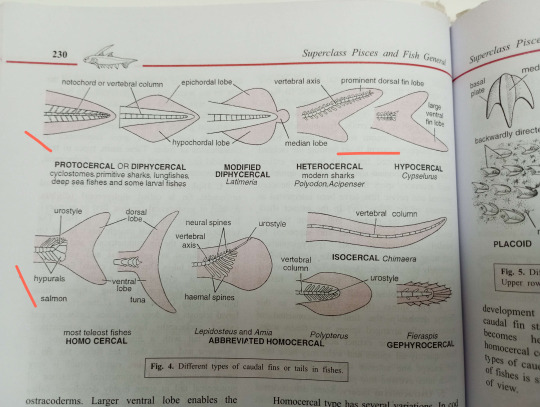
Types of Scales
There are 5 types of dermal scales: Cosmoid, Placoid, Ganoid, Cycloid, and Ctenoid.
1. Cosmoid Scales:
Does not occur in living fish, only fossilized fishes.
2. Placoid Scales:
Characteristic of sharks.
Each scale has a backwardly directed spine arising from a round or rhomboidal basal plate embedded in dermis.
Spine is enamel-like and basal plate is of dentine-like bony material.
A pulp cavity inside the spine opens through basal plate.
Placoid scales are closely set together in skin; giving a sandpaper like texture.
3. Ganoid Scales:
Thick, rhomboidal, or diamond shaped plates closely fitted side by side. Tile like, provide a bony armor to the fish, might overlap in some.
Characteristic of holosteans.
4. Cycloid Scales:
Thin, flexible. translucent plates. Circular in outline and thicker in the center.
Marked with several concentric lines of growth which can be used to determine age.
They overlap each other, each scale is embedded in a small pocket of dermis.
Found in lung fishes, carp, cod, etc.
5. Ctenoid Scales:
Similar to cycloid scales in form, structure, and arrangement.
But is more firmly attached, their free hind parts with are not overlapped, bear numerous small comb-like teeth or spines.
Characteristic of modern higher teleosteans like perch and sunfish.
There are some intermediate types of scales found in between cycloid and ctenoid, and some fish like flounder have both.
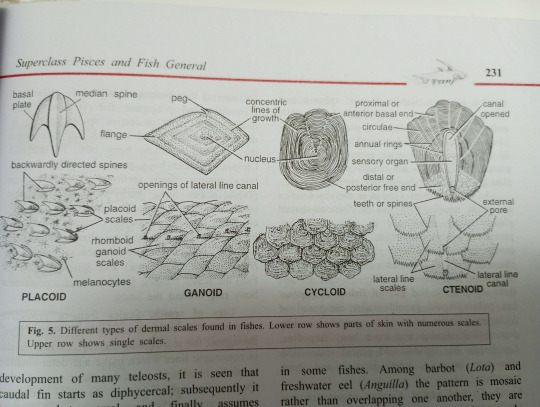
Neoteny and Paedogenesis
Neoteny refers to the retention of a larval or embryonic trait in the adult body. For example the retention of larval gills in adult salamanders.
Paedogenesis refers to the development of gonads and or production of young by an immature larval animal. Examples are scattered in several groups or animals such as gall fly, liver fluke, and salamanders.
Neoteny emphasizes the retention of larval traits in the adult body while paedogenesis stresses the development of adult like gonads in the larval body.
The best example of neoteny and paedogenesis is ambystomata. Normally they live through an aquatic larval stage and transform into an air-breathing terrestrial adult. However, under certain circumstances, the larvae does not undergo metamorphosis, retains it's gills and aquatic nature, but becomes sexually mature. This sexually mature larval stage with external gills is called an axolotl.
For a while axolotls were thought to be an entirely separate genus, Siredon.
Environmental factors affect metamorphosis in many ways. Abundance of food, cold temp., and insufficient iodine may cause failure of metamorphosis and paedogenesis. This is known because drying of swamps, lack of food, and rise in temp induce axolotls to metamorphose. When treated with thyroxine or TSH, they lose their gills and become adults.
There are 3 types of neoteny, partial, intermediate and total.
Partial neoteny is then metamorphosis is delayed due to temporary ecological or physiological changes, seen in tadpoles over winter.
Intermediate neoteny is when the organism is sexually reproductive and can undergo metamorphosis under the correct conditions, seen in axolotl.
Total neoteny is when they remain larval throughout. Even after treatment of thyroxine, they fail to metamorphose. Seen in Siren.
Parental Care in Amphibians
Parental care is the act of looking after the eggs or young until they are independent enough to defend from predators.
Amphibians exhibit various types of parental care in two broad groups: Protection by nests, nurseries, or shelters and direct caring by parents.
Protection by nests, nurseries, or shelters:
1. Selection of site: Many amphibians lay their eggs in protected moist microhabitats. Some frogs and toads lay eggs on land near water. Many tree frogs lay their eggs on leave and branched overhanding water by gluing their eggs, they fall into water free of predators when hatched. Some tree frogs deposit eggs in water that accumulates in epiphytic tropical plants, free from aquatic predators.
2. Defending eggs or territories: Male green Rana frogs maintain territories and attack small intruders to protect the eggs. Both male and female Mantophryne frogs guard the eggs. The male actually sits over and holds the gelatinous envelope containing 17 eggs.
3. Direct Development: In some frogs such as Hyla, the eggs hatch directly into little frogs, thus avoiding the chance of larval mortality. In the red backed salamander, the hatchlings are miniature adults.
4. Foam Nests: Many amphibians convert copious mucous secretion into nests for young. Japanese tree frogs dig a hole or tunnel into which eggs are left in a frothy mass to avoid desiccation. During rain, the hatching tadpoles are washed down the slopping tunnel into pond or river water for further development. Some frogs lay eggs in nests of foam floating on water. The female emits a huge amount of mucus that she can beats into foam with her hindlegs to lay eggs in. When tadpoles hatch they drop from foam into water.
5. Mud nests: Brazilian tree frog, Hyla, the male frog digs little holes in the mud of shallow water for the female frog to lay eggs in. The nest is 30cm in diameter and 5-8cm deep. Tadpoles hatch within this safe place and develop until they are large enough to defend themselves.
6. Tree nests: The South American Tree frog, Phyllomedusa, lays eggs in a folded leaf nest with margins glued together with cloacal secretions. The tadpoles when formed fall straight into water below.
7. Gelatinous bags: Salamandrella, a small aquatic salamander, deposits 50-60 small eggs in a gelatinous bag which is fastened to aquatic plants.
Direct Carrying By Parent
1. Coiling around eggs: In certain caecilians like Ichthyophis, the female lays large eggs in burrows in damp soil and carefully guards them by coiling her body around them until they hatch.
2. Transferring tadpoles to water: Some species of small frogs in tropical Africa and South America deposit their eggs on ground. Once the tadpoles hatch, they fasten themselves to the back of one of the parents with their sucker like mouth so they can be transported to water.
3. Eggs glued to body: Many amphibians carry the eggs glued to their body. In the Sri Lankan tree frog, the eggs are glued to the belly of the female. In the European midwife toad, Alytes, the mall entangles the eggs around his hindlegs so he can carry them with him until they are ready to hatch. When the time comes they release the tadpoles into the nearest water body.
4. Eggs in back pouches: In a group of tree frogs called marsupial frogs, the female carries the eggs on her back. Either in an open oval depression, a closed pouch, or individual pockets. The eggs develop into miniature frogs before leaving their mother's back.
5. Organs as brooding pouches: Males of the terrestrial South American Darwin's frog, Rhinoderma, pushes at least 2 fertilized eggs into his large vocal sacs. There they undergo complete development to emerge out as fully formed froglets.
6. Viviparity: Some anurans are ovoviviparous. They reatain eggs in the oviducts and the female gives birth to living young. For example African toads give birth to little frogs.
#zoology#vertebrates#fish#frog#neoteny#parental care#fins#scales#notes#biology#exam season#please help#amphibians#axolotl
64 notes
·
View notes
Text
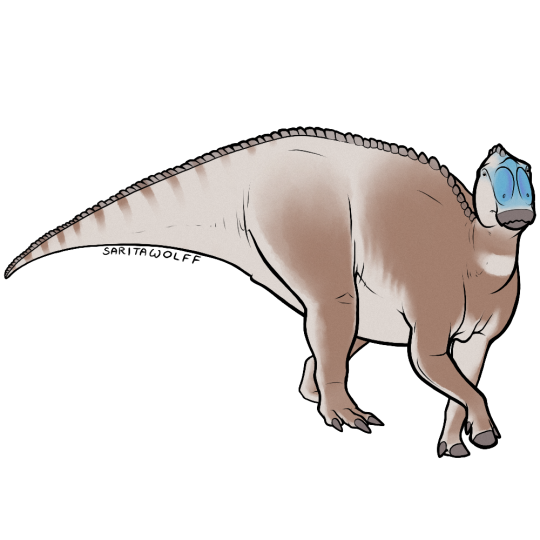
Patreon request for @/rome.and.stuff (Instagram) - Secernosaurus koerneri
Secernosaurus was a member of a small group of hadrosaurs native to South America: the Austrokritosaurs, and it was the first of this group to be formally named. Most hadrosaurs lived in Laurasia (what is now North America and Eurasia) which was seperated from South America in the Cretaceous. The existence of Secernosaurus and its relatives suggests a land bridge temporarily formed between North and South America at this time, allowing North American kritosaurines to migrate South.
So far, only one specimen of Secernosaurus has been found. This fossil was previously thought to belong to a subadult, but recent study shows it was likely mature, or at least almost mature. This makes it the smallest of the Austrokritosaurs, only 4–5 metres (13–16 ft) long. Still a large animal, but rather small by hadrosaur standards!
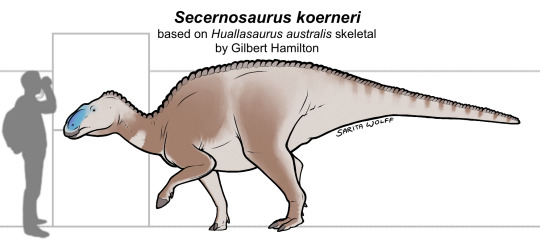
Secernosaurus received its big screen debut in Prehistoric Planet’s second episode, however, the design of the animals were based off the better known Huallasaurus australis, as Huallasaurus was thought to be a species of Secernosaurus at the time.
Secernosaurus koerneri lived in the Late Cretaceous Lago Colhué Huapí Formation In Argentina. As depicted in Prehistoric Planet, this environment was semi-arid with large deposits of gypsum, and fluctuated between seasonally wet conditions and intense aridization. But Secernosaurus wasn’t the only dinosaur in this environment. It shared the formation with titanosaurs like Elaltitan lilloi, Argyrosaurus superbus, and Aeolosaurus rionegrinus. Fragmentary remains of dromaeosaurids and megaraptorids have been found here, as well as the ornithischians Notoceratops (which could have been either a ceratopsian or another hadrosaur) and Sektensaurus (a possible elasmarian). Turtles, pseudosuchians, and lungfish have also been found, which would have made use of the floodplains during the wet season and possibly aestivated during the dry.
#Secernosaurus koerneri#Secernosaurus#kritosaurine#saurolophine#hadrosaurs#hadrosaurids#ornithopods#ornithischians#dinosaurs#archosaurs#archosauromorphs#reptiles#Lago Colhué Huapí Formation#Late Cretaceous#Argentina
28 notes
·
View notes